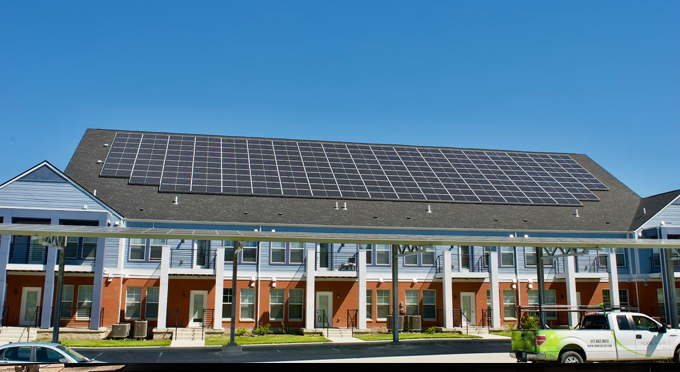
Building green in commercial construction offers a range of benefits, both for businesses and the environment. These advantages are driving a shift towards sustainable and environmentally responsible building practices in the commercial real estate sector.
1. Energy Efficiency
Green buildings are designed to be highly energy-efficient. They often incorporate features like advanced insulation, energy-efficient HVAC systems, LED lighting, and smart controls. This leads to significant cost savings on energy bills, making green buildings more economically viable in the long run.
2. Environmental Benefits
One of the most significant advantages of green commercial construction is its positive impact on the environment. Reduced energy consumption and the use of sustainable materials and practices result in lower greenhouse gas emissions, decreased water usage, and less waste generation.
3. Cost Savings
While initial construction costs for green buildings may be slightly higher, the long-term operational cost savings far outweigh these upfront expenses. Lower energy and water bills, reduced maintenance costs, and potential tax incentives make green buildings financially attractive.
4. Improved Indoor Air Quality
Green buildings prioritize indoor air quality, which contributes to the well-being and productivity of occupants. Enhanced ventilation, low-toxicity building materials, and efficient HVAC systems result in healthier indoor environments.
5. Higher Property Values
Green commercial buildings often have higher property values due to their energy efficiency, environmental benefits, and positive impact on the local community. They tend to be more attractive to investors and tenants alike.
6. Enhanced Brand Reputation
Companies that operate from green buildings can showcase their commitment to sustainability. This enhances their brand image and demonstrates social responsibility, which can be a competitive advantage.
7. Regulatory Compliance
As environmental regulations become stricter, green buildings are more likely to meet and exceed compliance standards. This reduces the risk of fines and penalties associated with non-compliance.
8. Tenant Attraction and Retention
Green buildings are often preferred by tenants, especially those with a focus on sustainability. Commercial property owners can attract and retain tenants more easily by providing energy-efficient and environmentally responsible spaces.
9. Resilience to Climate Change
Green buildings are designed to be more resilient in the face of climate change-related challenges, such as extreme weather events. This can lead to lower insurance costs and fewer disruptions to business operations.
10. Employee Productivity
Improved indoor air quality and natural lighting in green buildings contribute to increased employee comfort and productivity. Businesses operating from green offices may experience reduced absenteeism and higher employee retention rates.
11. Access to Incentives
Many governments and municipalities offer incentives for green building construction, such as tax credits and grants. These incentives can significantly offset the initial costs of green building development.
12. Competitive Advantage
As the demand for environmentally responsible practices grows, having a green commercial building can provide a competitive advantage in the real estate market. Businesses operating from such properties may attract customers and clients who value sustainability.
13. Future-Proofing Investments
Green buildings are more likely to remain competitive in the evolving real estate landscape. They anticipate future environmental and energy efficiency standards, ensuring that investments stand the test of time.
Green building practices in commercial construction represent an opportunity to align financial interests with environmental responsibility. With the potential for substantial cost savings, improved environmental stewardship, and positive effects on occupants, the shift towards green building in commercial real estate is likely to continue to gain momentum.
What Are The Downsides?
While building green in commercial construction offers numerous benefits, there are also some downsides and challenges associated with these practices:
Higher Initial Costs: Green building materials and technologies can be more expensive upfront. While they often result in long-term cost savings, some businesses may be deterred by the initial investment required.
Complex Certification Processes: Achieving green building certifications, such as LEED (Leadership in Energy and Environmental Design), can be a time-consuming and paperwork-intensive process. This may be challenging for developers and building owners.
Limited Availability of Green Materials: In some regions, it can be challenging to source green building materials and technologies, leading to longer construction timelines and potential delays.
Skilled Labor Shortages: Green building practices often require specialized knowledge and skills. Finding qualified contractors and workers with expertise in green construction can be difficult in some areas.
Market Perception: Some businesses and investors may perceive green building as a niche or expensive option, potentially affecting marketability and tenant attraction.
Maintenance Complexity: Some green building features, such as living roofs or advanced HVAC systems, can be more complex to maintain and may require specialized knowledge.
Limited Design Flexibility: Certain green building elements, like solar panels or passive design principles, may limit architectural and design choices.
Resale Challenges: While green buildings may have higher property values, selling them can be more challenging due to the limited pool of potential buyers and their specialized knowledge requirements.
Performance Variability: The actual performance of green building features can vary based on factors like climate, location, and user behavior. This can lead to suboptimal results in some cases.
Regulatory Uncertainty: Green building standards and regulations are continually evolving. Staying compliant with changing rules and certifications can be complex.
Payback Period: The time it takes to recoup the upfront investment in green building features may not align with short-term financial goals for some businesses.
Upfront Planning: Successfully incorporating green building practices requires thorough planning from the design stage, which can be more time-consuming and complex than traditional construction.
It’s important to note that many of these downsides can be mitigated with proper planning, awareness, and expertise. As the green building industry continues to grow, solutions to these challenges are also emerging. For many, the long-term benefits and positive environmental impact of green building outweigh these downsides.
What Companies Are Known For Green Building Practices?
Several companies are known for their commitment to green building practices and sustainability. These organizations have made significant strides in constructing environmentally responsible and energy-efficient buildings. Here are some notable examples:
- Skanska: Skanska is a global construction company that has prioritized sustainability in its projects. They are known for their LEED-certified buildings and focus on green construction practices.
- HOK: HOK is a renowned architectural firm that incorporates sustainable design principles in many of its projects. They are recognized for their innovative green building solutions.
- WELL Building Institute: The WELL Building Standard focuses on creating healthy and sustainable buildings. The WELL Building Institute collaborates with various companies to implement these principles.
- Sustainable Energy Partners: This company specializes in constructing net-zero and energy-efficient buildings, emphasizing renewable energy and energy conservation.
- Turner Construction Company: Turner has a strong commitment to sustainability and green building practices, with numerous LEED-certified projects in their portfolio.
- Gensler: Gensler is an architecture and design firm that integrates sustainability into its projects. They have a reputation for creating environmentally responsible and efficient spaces.
- Sustainable Design Group: This firm specializes in green building design and offers services related to energy-efficient construction and sustainable practices.
- AECOM: AECOM is a multinational engineering firm that works on a variety of infrastructure and construction projects with a focus on sustainability.
- Perkins and Will: Perkins and Will is an architecture and design firm known for its commitment to sustainable design and green building principles.
- Balfour Beatty: Balfour Beatty is a construction and infrastructure company that emphasizes sustainability and green construction in its projects.
- Forest City Realty Trust: This real estate development company focuses on sustainable and energy-efficient properties, including green building practices in their developments.
- SOM (Skidmore, Owings & Merrill LLP): SOM is a global architectural firm that incorporates sustainable and green design strategies in its projects.
- BNP Paribas Real Estate: This real estate company actively promotes sustainable and environmentally friendly practices in their projects.
- Prologis: Prologis is a logistics real estate company that is dedicated to green and sustainable building practices in their distribution centers and warehouses.
- CBRE Group: CBRE is a commercial real estate services and investment firm that supports sustainable real estate practices in their operations and projects.
These are just a few examples of companies and organizations known for their commitment to green building practices. The list continues to grow as sustainability becomes an integral part of the construction and real estate industry.





 Ordering Info
Ordering Info Customer Service
Customer Service Follow Us
Follow Us Search For Stuff
Search For Stuff Find Us
Find Us Call Us
Call Us Pay Us
Pay Us

0 Comments so far.
Use the form below to add your own thoughts or questions. Scroll down to read what other people had to say.